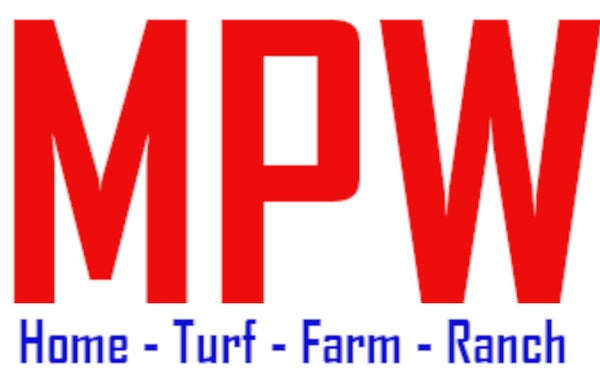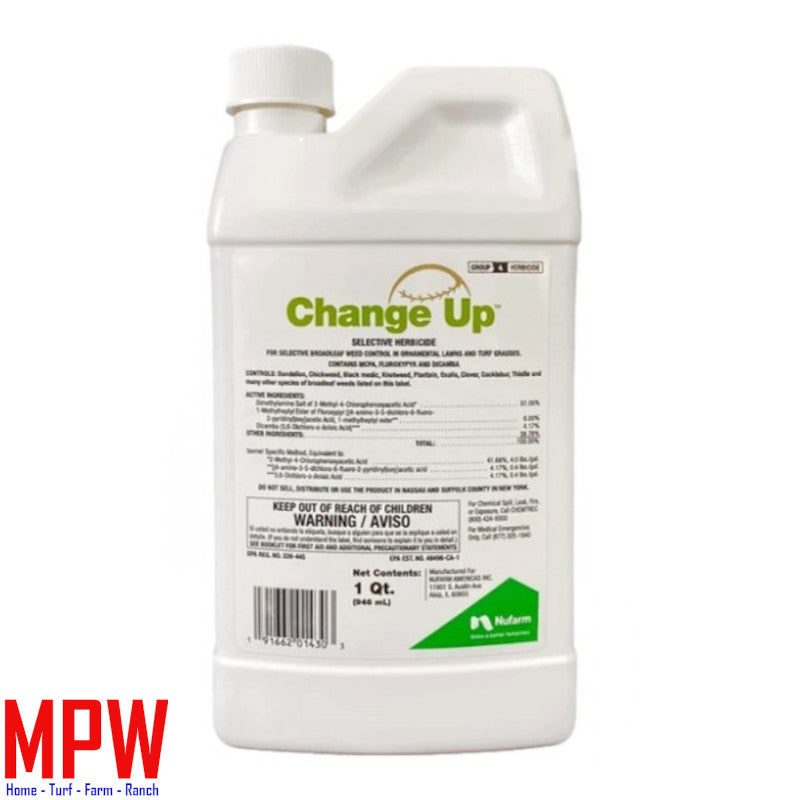Change Up™ premium selective herbicide combines MCPA, fluroxypyr and dicamba to deliver powerful weed control results. An excellent herbicide for cool and warm season turf, Change Up controls more than 200 broadleaf weeds and it starts working quickly to strike out weeds and help reduce callbacks. Plus, Change Up is ideal for any accounts that may be sensitive to the use of 2,4-D on the property.
MyPestWarehouse
Change Up Herbicide 2.5 Gallon
Change Up Herbicide 2.5 Gallon
Couldn't load pickup availability
MAXIMUM POWER. CONVENIENT FORMULA.
- Transition zone convenience of spraying both warm and cool season turfgrass without having to change herbicides
- Offers the power of three proven herbicides in one convenient pre-mixed formulation
- Contains MCPA – ideal for accounts requesting a 2,4-D alternative
- Labeled for cool- and warm-season turfgrass including Bahiagrass, Creeping bentgrass, Bermudagrass, Kentucky bluegrass, Ryegrass, Fescue, Carpetgrass, Centipedegrass, Zoysiagrass and St. Augustinegrass
- Reduced callbacks following a quick visual response and excellent weed control
- Contains the pyridine herbicide fluroxypyr for unparalleled clover control
- Broad spectrum – excellent control of more than 200 broadleaf weeds including dandelion, plantain, oxalis, chickweed, thistles and other hard-to-control species
- Convenient to use – tank-mix compatible with a number of liquid fertilizers and iron formulations
APPLICATION RECOMMENDATIONS
Ornamental lawns, golf course and athletic field turf:
For Kentucky bluegrass, Ryegrass and Fescue, apply 2 to 3 pints per acre. For Creeping bentgrass use 1.25 pints per acre. For Common and Hybrid Bermudagrass, Bahiagrass, Carpetgrass, Centipedegrass and Zoysiagrass apply 1.5 to 2 pints per acre. For St. Augustinegrass apply 1 pint per acre.
Do not apply more than 3 pints product per acre per application. Do not apply more than two applications per year with a minimum retreatment interval of 21 days.
Maximum control of weeds will occur from spring or early fall applications when weeds are actively growing. The degree of weed control and duration of effect will vary with weed size and density, spray rate and coverage, and growing conditions before, during and after the time of treatment. Use the higher rate for hard to control weeds.
For optimum results:
(1) avoid applying during excessively hot or dry periods unless irrigation
is used, (2) turf should not be mowed 1-2 days before and following application, (3) reseed no sooner than 3-4 weeks after application of this product.
Adding oil, wetting agent or other surfactant to the spray may be used to increase effectiveness on weeds but doing so may reduce selectivity to turf resulting in turf damage.
Do not exceed specified dosages for any area. Be particularly careful within the drip line of trees or other ornamental species. Do not apply to newly seeded grasses until well established. Avoid broadcast applications when air temperature exceeds 90ºF. When using in small, spot treatment applications in temperatures over 90ºF, turf injury may occur.
When treating carpetgrass and St. Augustinegrass, avoid broadcast applications when air temperature exceeds 80ºF. When air temperature exceeds 80ºF limit these applications to spot treatment only.
Note:
For all grasses (1) avoid double coverage resulting from overlap unless temporary turf injury can be tolerated and (2) use reduced rates if grass is stressed from heat, drought, etc.
Lower volume applications:
Use as little as 5 gallons of water per acre. Use only application equipment that is capable of spreading a uniform droplet, wetting each weed surface.
Sod Farms:
For Bluegrass, Ryegrass and Fescue, apply 2 to 3 pints per acre. For Creeping bentgrass use 1.25 pints per acre. For Common and Hybrid Bermudagrass, Bahia and Zoysia apply 1.5 to 2.0 pints per acre. For St. Augustinegrass apply 1 pint per acre. Spray volume for sod farm application is 5 to 175 gallons per acre.
For sod farm use, do not apply more than 3 pints product per acre per application. Do not apply more than 2 broadcast applications per year (excluding spot treatments) with a minimum retreatment interval of 21 days.
See label for complete application rates and recommendations.
Share


